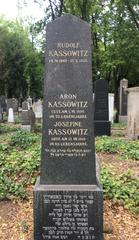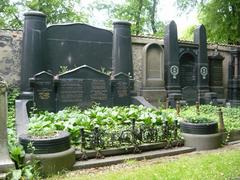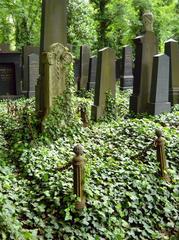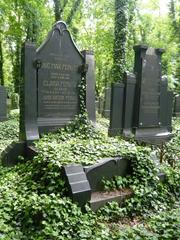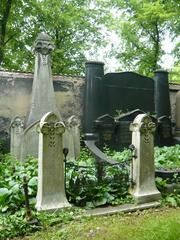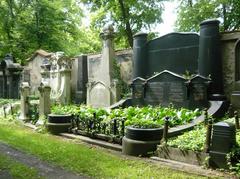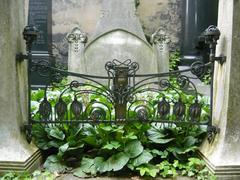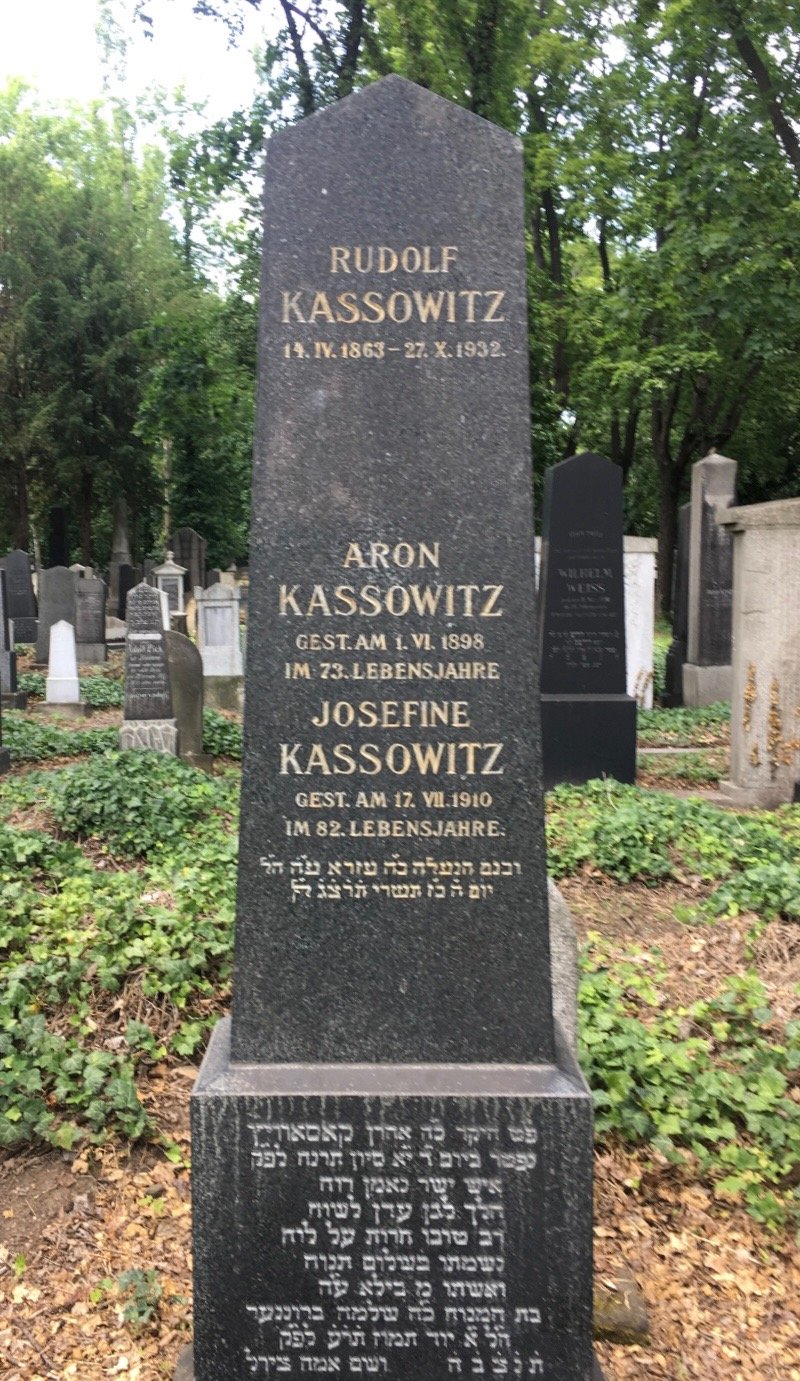
New Jewish Cemetery Prague: Visiting Hours, Tickets, and Comprehensive Historical Guide
Date: 14/06/2025
Introduction
The New Jewish Cemetery (Nový židovský hřbitov) in Prague is one of the city’s most profound cultural landmarks, embodying more than a century of Jewish history, art, and resilience. Established in 1890 in the Žižkov district, this cemetery replaced the overcrowded Old Jewish Cemetery in Josefov and became the city’s principal and only active Jewish burial ground today. Beyond its function as a resting place, the cemetery is an open-air gallery of funerary art, featuring styles from Neo-Renaissance and Art Nouveau to Constructivism, shaped by renowned Czech architects and sculptors. Most famously, it is the final resting place of Franz Kafka, drawing literary pilgrims worldwide. This guide details the cemetery’s history, notable burials, architectural features, practical visitor information, and travel tips, ensuring a respectful and enriching experience for all visitors (synagogue.cz, jguideeurope.org, frommers.com, prague.eu, radio.cz).
Table of Contents
- Introduction
- Historical Background and Urban Context
- Design and Artistic Features
- Notable Burials and Memorials
- Evolution and Restoration
- Visitor Information
- Frequently Asked Questions (FAQ)
- Conclusion and Call to Action
- References
Historical Background and Urban Context
The New Jewish Cemetery was established in 1890 as Prague’s Jewish population expanded and the old Josefov cemetery reached capacity (synagogue.cz). The move corresponded with Jewish emancipation and urban development, as Jews gained civil rights and integrated into broader Czech society. Located in Žižkov, outside the old city center, the cemetery’s site followed Emperor Joseph II’s reforms prohibiting burials within city limits (expats.cz). Today, the cemetery occupies over 10 hectares and is the largest Jewish cemetery in Prague.
Design and Artistic Features
Layout and Structures
The cemetery was meticulously planned to accommodate around 100,000 graves, though it has yet to reach full capacity due to the tragic reduction of Prague’s Jewish population during the Holocaust (Porges.net). Distinct from the haphazard arrangement of older cemeteries, graves here are organized in regular fields, with family plots and honorary sections for rabbis and community leaders. The ceremonial axis is lined with mature trees, leading from the ornate Neo-Renaissance funeral parlor—designed by Bedřich Münzberger—to the heart of the cemetery.
Architectural Styles and Artists
The cemetery is noted for its variety of funerary art and architectural styles, including Neo-Gothic, Neo-Renaissance, Art Nouveau, Classicism, Purism, and Constructivism. Many tombstones and monuments were designed by leading Czech architects and artists such as Jan Kotěra, Josef Zasche, Josef Fanta, Čeněk Vosmík, and Paul Albert Kopetzky. Sculptor Josef Václav Myslbek’s final works adorn the Waldes family tomb (radio.cz).
More than 100 tombstones are recognized as cultural monuments by Prague’s Center of Monuments Preservation, testifying to their artistic and historical value (Porges.net).
Notable Burials and Memorials
Franz Kafka
The cemetery’s most famous grave is that of Franz Kafka (1883–1924), located at tombstone 21–14–21, alongside his parents. Kafka’s grave is modest and inscribed in both Hebrew and German, reflecting the multiculturalism of Prague’s Jewish community. Max Brod, Kafka’s close friend and literary executor, is buried opposite (frommers.com, besidestheobvious.net).
Rabbis and Intellectuals
Prominent graves near the entrance honor rabbis like Dr. Nathan Ehrenfeld and Dr. Gustav Sicher, both notable leaders in Prague’s Jewish religious life (kehilaprag.cz). The cemetery also holds the remains of influential artists and intellectuals, including architect Jan Kotěra, Josef Zasche, Josef Fanta, and sculptor Čeněk Vosmík (prague.eu), as well as poets, writers, and directors such as Jiří Ornest, Ota Pavel, and Zeno Dostál.
Lavish Family Tombs
The eastern wall is lined with elaborate tombs of notable families such as the Petscheks and Waldeses—both significant in Prague’s economic and cultural life. The Waldes tomb, with its Myslbek busts, is a highlight (kehilaprag.cz).
Holocaust and Resistance Memorials
A striking 1985 Memorial, designed by Zdeněk Vodička and Vladimír Stehlík, commemorates Czechoslovak Jews who perished in the Holocaust and the Resistance. The Patria Ship Memorial recalls the 1940 ship disaster that claimed the lives of Jewish refugees. Other significant monuments include the memorial to Dolní Královice’s lost Jewish community, a World War I memorial, and a symbolic tomb containing remains from Prague’s oldest Jewish burial ground (prague.eu, kehilaprag.cz, Wikipedia).
Evolution and Restoration
The New Jewish Cemetery survived Nazi occupation, in part due to Nazi plans to create a “museum of an extinct race” in Prague (dreamplanexperience.com). After WWII, the Jewish community’s decline led to underuse, but the site remained Prague’s sole active Jewish burial ground. Restoration efforts have accelerated in recent years; between 2023 and 2024, nearly 500 tombstones and three family vaults were restored, primarily funded by Norway Grants (radio.cz). A comprehensive online grave locator supports visitors seeking specific graves.
Visitor Information
Visiting Hours and Tickets
- Hours: Sunday–Thursday 9:00–16:00 (extended to 17:00 in summer), Friday 9:00–14:00. Closed on Saturdays and Jewish holidays (prague.eu).
- Admission: Entry is generally free. Guided tours may require booking and fees; check official sources for updates.
- Tickets: Purchase on-site or online via Jewish Community of Prague or authorized vendors.
Accessibility
Main avenues and the ceremonial hall are accessible to wheelchairs, though some historic paths may be uneven. Visitor assistance is available on request.
Guided Tours and Audio Guides
Guided tours in multiple languages are available and recommended for deep historical and cultural context. Audio guides and brochures can be obtained on-site or via the Audiala app.
Nearby Attractions and Travel Tips
- Location: Izraelská 1, 130 00, Žižkov, Prague 3 (prague.eu).
- Transport: Easily accessed by tram and metro (Želivského station).
- Nearby Sites: Combine your visit with the Old Jewish Cemetery, Jewish Museum, Pinkas Synagogue, and the vibrant Žižkov neighborhood.
- Best Time: Spring and early autumn are ideal for pleasant weather and fewer crowds.
Photography and Etiquette
Photography is permitted but should be respectful; avoid flash, especially during ceremonies, and observe all signage. Dress modestly and maintain quiet out of respect for mourners and the sacred setting.
Frequently Asked Questions (FAQ)
Q: What are the New Jewish Cemetery Prague opening hours?
A: Sunday–Thursday 9:00–16:00 (to 17:00 in summer); Friday 9:00–14:00; closed Saturdays and Jewish holidays.
Q: Do I need a ticket?
A: Entry is typically free, but guided tours may require a fee.
Q: Are guided tours available?
A: Yes, through local operators and the Jewish Museum. Booking ahead is advised.
Q: Is Franz Kafka’s grave easy to find?
A: Kafka’s grave is at tombstone 21–14–21. Use the online grave locator or cemetery map.
Q: Is the cemetery wheelchair accessible?
A: Main areas are accessible; some paths are uneven. Assistance is available.
Q: Can I take photos?
A: Yes, but be respectful and avoid flash or tripods near active graves or ceremonies.
Conclusion and Call to Action
The New Jewish Cemetery is a living testament to Prague’s Jewish legacy—combining history, art, architecture, and memory. From Kafka’s grave to the Holocaust memorials and striking funerary monuments, the site offers a powerful space for reflection and discovery. Plan your visit by checking current hours and tour options, use the online grave locator for notable burials, and consider enhancing your experience with a guided tour or the Audiala app.
For a deeper dive into Prague’s Jewish heritage, explore nearby historical sites, visit the Jewish Museum, and follow us on social media for the latest updates and travel tips. Download the Audiala app for immersive audio guides and interactive maps of Prague’s most significant landmarks.
References
- Visiting the New Jewish Cemetery Prague: History, Tickets, and Travel Tips, 2023 (synagogue.cz)
- Exploring the New Jewish Cemetery in Prague: History, Art, and Visitor Information, 2023 (jguideeurope.org)
- Nearly 500 Tombstones Restored at Prague’s New Jewish Cemetery, 2023 (radio.cz)
- The Hidden Cemeteries of Prague, 2023 (expats.cz)
- New Jewish Cemetery (Nový židovský hřbitov), Prague.eu Official Tourism Portal (prague.eu)
- New Jewish Cemetery of Prague: The Grave of Franz Kafka, 2023 (besidestheobvious.net)
- Cemeteries in Prague: Artistic and Historical Highlights (viewfromprague.com)
- A Guide to Prague’s Historical Quarters: Jewish Quarter, 2023 (dreamplanexperience.com)
- Jewish Cemetery Details (kehilaprag.cz)
- New Jewish Cemetery, Prague - Porges.net (Porges.net)
- Jewish Museum in Prague Official Website (jewishmuseum.cz)
- New Jewish Cemetery, Prague - Wikipedia (Wikipedia)
- New Jewish Cemetery Prague: Visiting Hours, Tickets, and Artistic Highlights, 2023 (Porges.net)
